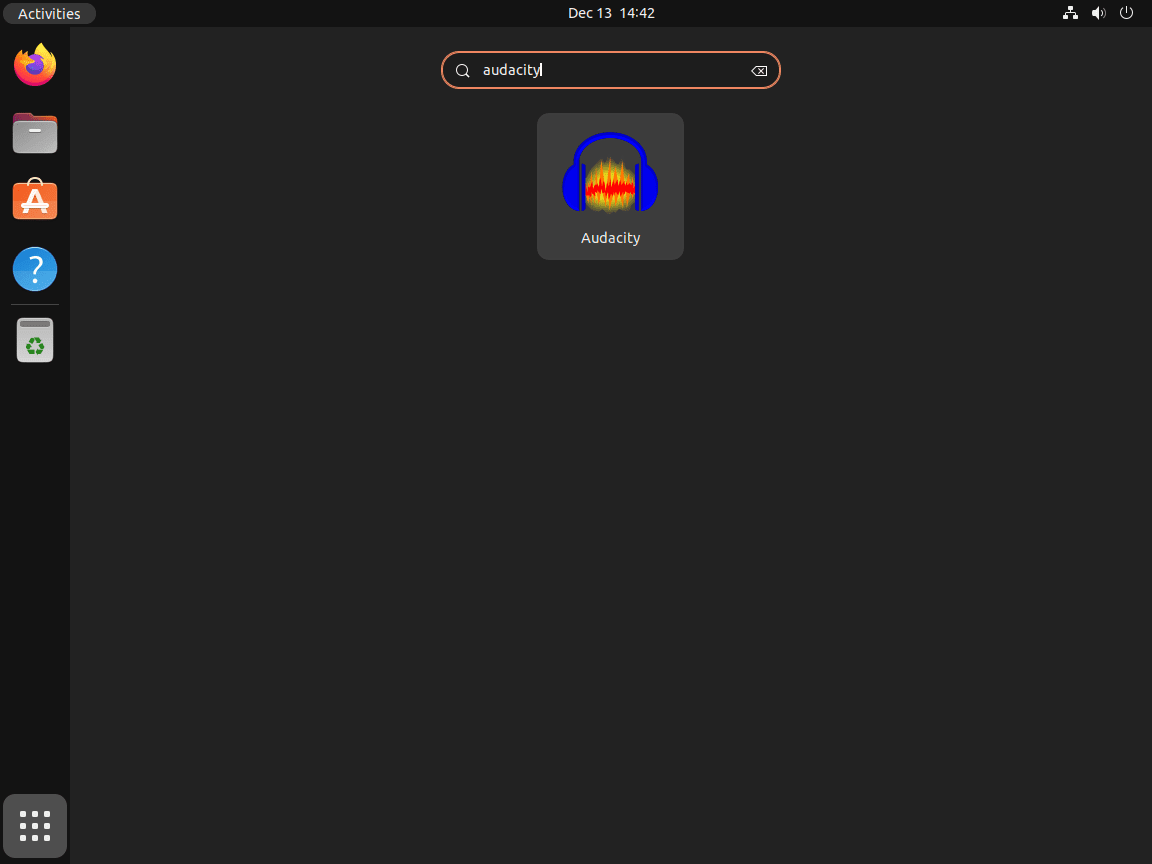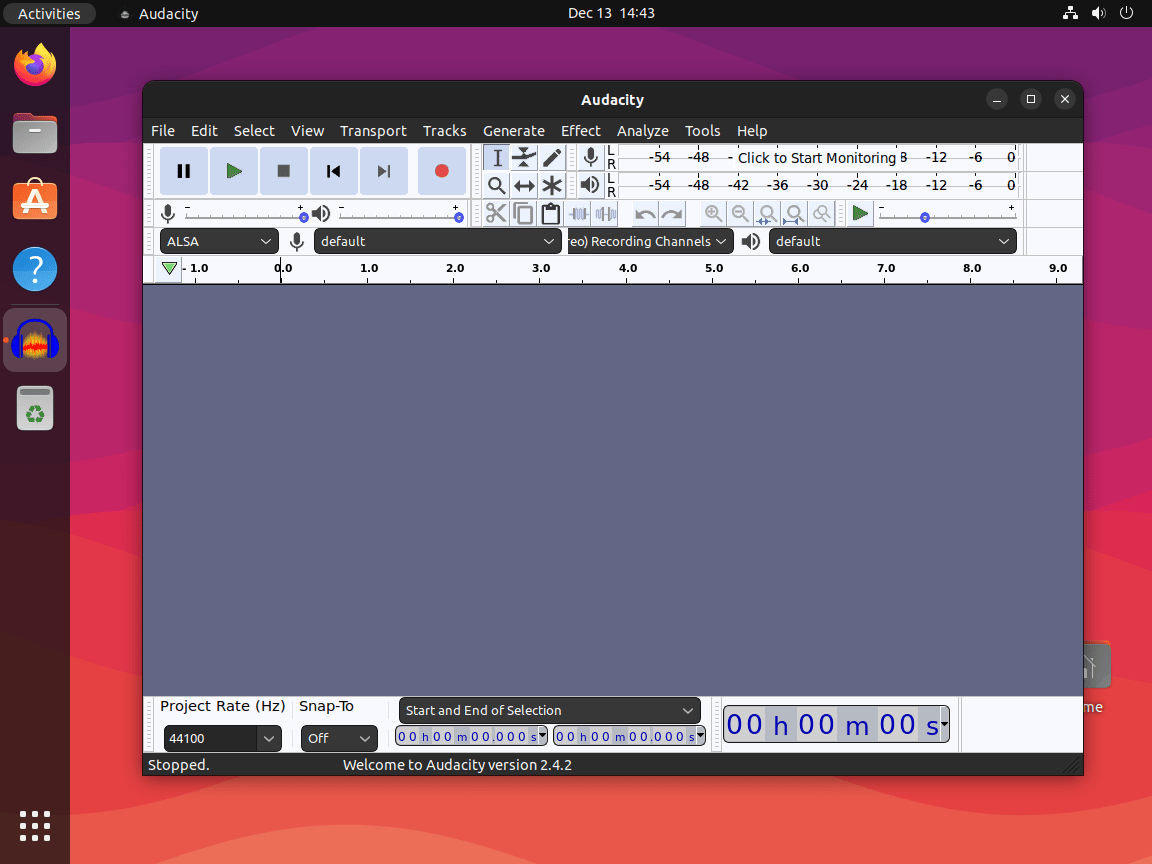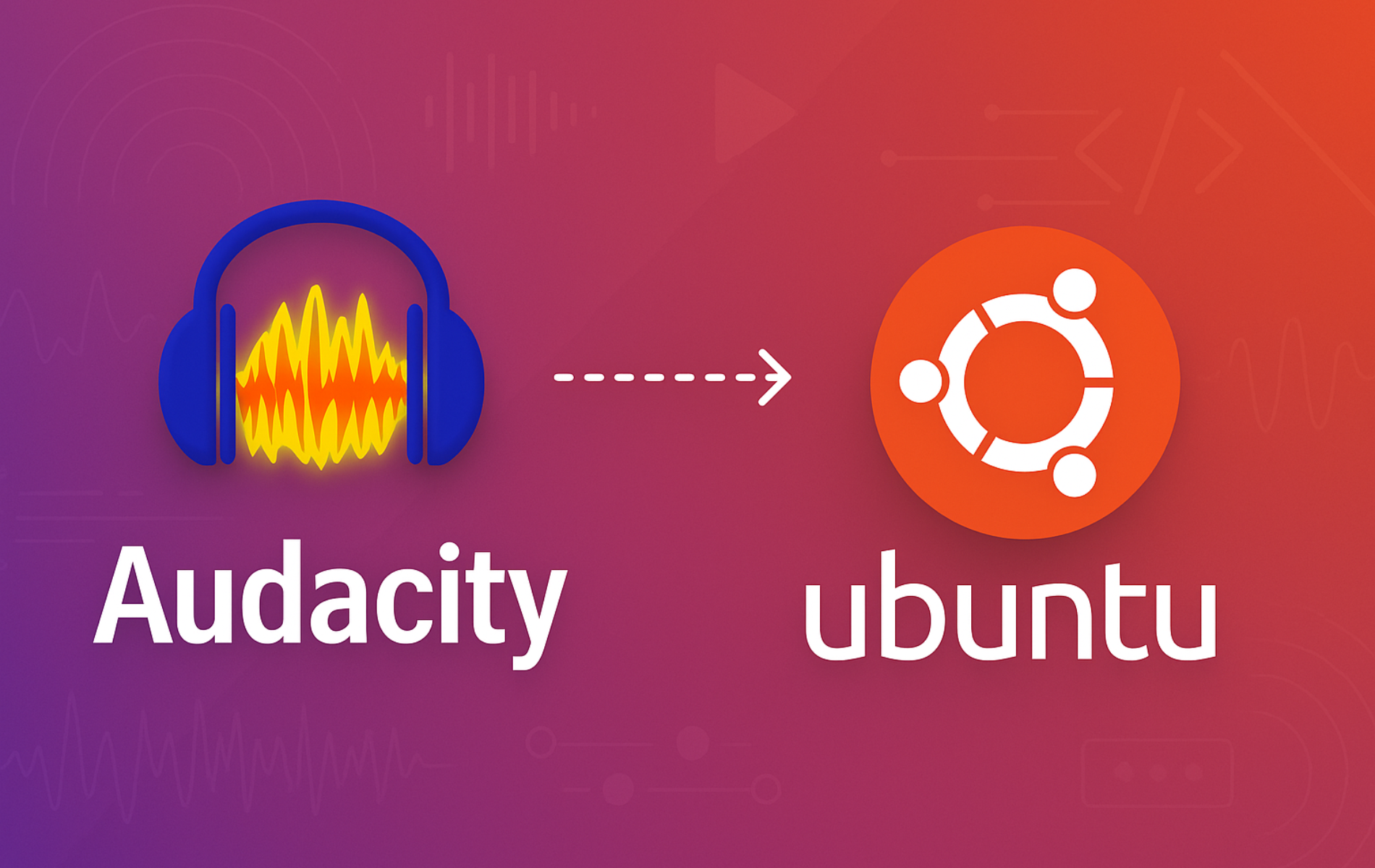Audacity is a free, open-source audio editor that lets you record live audio, convert tapes and records to digital formats, edit WAV, AIFF, FLAC, MP3, and OGG files, and apply effects like noise reduction and equalization. Whether you’re creating podcasts, editing music tracks, or cleaning up voice recordings, Audacity provides multi-track editing with support for VST and LV2 plugins. This guide covers four installation methods (APT, PPA, Snap, and Flatpak), along with troubleshooting steps for common audio device issues.
Choose Your Audacity Installation Method
Ubuntu offers multiple installation paths for Audacity, each with different trade-offs between version freshness, update mechanisms, and sandboxing.
| Method | Channel | Version | Updates | Best For |
|---|---|---|---|---|
| APT (Default) | Ubuntu Repos | 2.4.2 (22.04) / 3.4.2 (24.04) | Automatic via apt upgrade | Users who prioritize stability over features |
| APT (PPA) | ubuntuhandbook1 PPA | 3.7.6 (latest stable) | Automatic via apt upgrade | Users who need the latest features on any LTS |
| Snap | Snapcraft | 3.7.5 | Automatic background updates | Users who prefer automatic updates with sandboxing |
| Flatpak | Flathub | 3.7.7 | Manual via flatpak update | Users who prefer Flatpak sandboxing |
For Ubuntu 24.04 users, the APT default repository is recommended because it provides a modern Audacity 3.x release with automatic security updates. However, Ubuntu 22.04 users should consider the PPA, Snap, or Flatpak since the default repository only offers Audacity 2.4.2 (released in 2020), which lacks significant features like real-time effects, improved noise reduction, and the modernized interface introduced in the 3.x series.
This guide supports Ubuntu 22.04 LTS and 24.04 LTS installations. Ubuntu 22.04 includes Audacity 2.4.2 in its default repository, while Ubuntu 24.04 provides Audacity 3.4.2 (with 3.7.3 available via backports). For users on 22.04 who need modern features like real-time effects preview, improved noise reduction, or the redesigned interface, the PPA, Snap, or Flatpak methods provide current 3.7.x releases.
Method 1: Install Audacity via APT
Update Ubuntu System Packages
First, refresh your package index to ensure you install the latest available version. This step prevents potential dependency conflicts during installation:
sudo apt update && sudo apt upgradeOption 1: Install Audacity from Ubuntu Repository
Typically, the default Ubuntu repository provides a stable, tested version of Audacity that receives security updates automatically. Install it with:
sudo apt install audacityOnce installation completes, verify it by checking the installed package:
apt-cache policy audacityThe output shows the installed version, which varies by Ubuntu release:
audacity: Installed: 3.4.2+dfsg-1build4 Candidate: 3.4.2+dfsg-1build4
On Ubuntu 22.04, the output shows version
2.4.2~dfsg0-5instead. If you need a newer version on 22.04, continue with the PPA method below or use Snap/Flatpak.
Option 2: Install Audacity from ubuntuhandbook1 PPA
However, if you need the latest Audacity release with newer features, the ubuntuhandbook1 PPA provides up-to-date packages. First, add the PPA repository and update your package index:
sudo add-apt-repository ppa:ubuntuhandbook1/audacity -y
sudo apt updateNext, install Audacity from the PPA. If you already have the default repository version installed, this command upgrades it to the PPA version:
sudo apt install audacityVerify the installation to confirm you have the PPA version:
apt-cache policy audacityThe output should show the PPA URL as the package source:
audacity:
Installed: 3.7.6-0build1~ubuntu24.04
Candidate: 3.7.6-0build1~ubuntu24.04
500 https://ppa.launchpadcontent.net/ubuntuhandbook1/audacity/ubuntu noble/main amd64 Packages
Method 2: Install Audacity via Snap
Furthermore, Snap packages include all dependencies and run in a sandboxed environment. As Ubuntu includes Snap by default, you can install Audacity directly from the Snap Store:
sudo snap install audacityConveniently, Snap automatically handles updates in the background, keeping Audacity current without manual intervention. Verify the installation:
snap list audacityName Version Rev Tracking Publisher Notes audacity 3.7.5 1011 latest/stable snapcrafters -
Method 3: Install Audacity via Flatpak
However, Flatpak is not pre-installed on Ubuntu. If you have not set it up yet, install it with
sudo apt install flatpakand restart your session before continuing. For detailed setup including the Flathub repository, follow our Flatpak installation guide for Ubuntu.
Add Flathub Repository
Essentially, Flathub is the primary repository for Flatpak applications. Add it to your system if you haven’t already:
sudo flatpak remote-add --if-not-exists flathub https://flathub.org/repo/flathub.flatpakrepoInstall Audacity from Flathub
Subsequently, with Flathub configured, install Audacity using the --system flag to make it available for all users on the system:
sudo flatpak install --system flathub org.audacityteam.Audacity -yVerify the installation by listing installed Flatpak applications:
flatpak list --app | grep -i audacityAudacity org.audacityteam.Audacity 3.7.7 system
Launch Audacity
After installation, you can launch Audacity from the terminal or the applications menu, depending on your preference and installation method.
Launch Audacity from Terminal
For APT installations (default repository or PPA), run:
audacityAlternatively, for Snap installations:
snap run audacityLastly, for Flatpak installations:
flatpak run org.audacityteam.AudacityLaunch Audacity from Applications Menu
Undoubtedly, the easiest way to open Audacity is through the graphical applications menu:
- First, access your system’s application menu.
- Then, search for “Audacity” in the application list.
- Finally, click on the Audacity icon to start the application.


Troubleshoot Common Audacity Issues
Most Audacity problems on Ubuntu stem from audio device permissions, sound server compatibility, or sandboxing restrictions. The following solutions address the most frequently encountered issues.
No Audio Devices Detected
If Audacity shows no recording or playback devices, first verify your system detects your audio hardware. Run this diagnostic command:
aplay -lExpected output showing detected audio devices:
**** List of PLAYBACK Hardware Devices **** card 0: PCH [HDA Intel PCH], device 0: ALC892 Analog [ALC892 Analog] Subdevices: 1/1 Subdevice #0: subdevice #0
If aplay -l shows devices but Audacity does not, the issue is typically with Audacity’s audio host setting. Open Audacity, go to Edit → Preferences → Audio Settings, and change the Host dropdown from ALSA to PulseAudio (or PipeWire on Ubuntu 22.10+). Click OK and restart Audacity.
Flatpak or Snap Cannot Access Microphone
Sandboxed Audacity installations may lack permission to access your microphone. For Flatpak installations, verify and grant audio permissions:
flatpak info --show-permissions org.audacityteam.Audacity | grep -i pulseIf PulseAudio access is missing, override the permissions:
flatpak override --user --socket=pulseaudio org.audacityteam.AudacityFor Snap installations, ensure the audio-record interface is connected:
snap connections audacity | grep audioExpected output showing connected audio interfaces:
audio-playback audacity:audio-playback :audio-playback - audio-record audacity:audio-record :audio-record -
If audio-record shows as disconnected, connect it manually:
sudo snap connect audacity:audio-recordPlayback Stuttering or Crackling
Audio glitches during playback often result from buffer size settings. Open Edit → Preferences → Audio Settings and increase the Buffer Length value (try 200ms or higher). Higher values reduce stuttering but add latency, so find a balance that works for your hardware.
Additionally, check for system resource contention by closing other audio applications before recording. If using PipeWire, you can adjust the quantum (buffer) setting system-wide:
pw-metadata -n settings 0 clock.force-quantum 1024This increases the buffer to 1024 samples, reducing crackling at the cost of higher latency.
Manage Audacity
Update Audacity
Crucially, keep Audacity updated to receive new features, bug fixes, and security patches. However, the update method depends on how you installed it.
Update via APT
Specifically, for APT installations (default repository or PPA), update Audacity along with other system packages:
sudo apt update && sudo apt upgradeAlternatively, to update only Audacity without upgrading other packages:
sudo apt update && sudo apt install --only-upgrade audacityUpdate via Snap
In contrast, Snap packages update automatically in the background. To manually trigger an update for Audacity specifically:
sudo snap refresh audacityTo update all Snap packages at once:
sudo snap refreshUpdate via Flatpak
Likewise, for Flatpak installations, update Audacity with:
sudo flatpak updateRemove Audacity
If you need to uninstall Audacity, use the appropriate method based on how you installed it.
Remove via APT
To begin, remove Audacity installed from the default repository or PPA:
sudo apt remove audacityNext, clean up any orphaned dependencies that were installed alongside Audacity:
sudo apt autoremoveAdditionally, if you added the ubuntuhandbook1 PPA and want to remove it as well, run:
sudo add-apt-repository --remove ppa:ubuntuhandbook1/audacity -yFor more options on managing PPAs, see our guide on removing a PPA from Ubuntu.
Remove via Snap
To remove the Audacity Snap package:
sudo snap remove audacityRemove via Flatpak
Notably, the
--delete-dataflag permanently removes all Audacity user data, including saved projects and preferences. Omit this flag if you plan to reinstall Audacity later and want to keep your settings.
Finally, remove Audacity and its associated data:
sudo flatpak uninstall --system --delete-data org.audacityteam.Audacity -yAlternatively, to keep your settings, remove without the data deletion flag:
sudo flatpak uninstall --system org.audacityteam.Audacity -yConclusion
In summary, you now have Audacity installed on Ubuntu through your preferred method, whether that’s the stable APT repository, the latest version from the ubuntuhandbook1 PPA, or sandboxed installations via Snap or Flatpak. Each method receives updates differently, so keep in mind how you installed Audacity when performing maintenance. For related multimedia tools, consider installing OBS Studio for screen recording or VLC for media playback to complement your audio editing workflow.


